Management and Organization: Barriers to Change & Solutions
VerifiedAdded on 2023/06/12
|9
|2151
|347
Essay
AI Summary
This essay examines the barriers encountered during the implementation of change management within business organizations, focusing on technological obstacles and the conflicting vested interests of stakeholders. It discusses how resistance from employees due to skepticism about new technologies and a lack of motivation to adopt new processes can hinder change. Additionally, it addresses the challenge of differing opinions between management and employees, using Uber as an example of employee resistance due to conflicting interests. The essay further suggests utilizing Lewin’s change management model, which involves unfreezing existing processes, implementing changes in phases, and refreezing by evaluating the effectiveness of the implemented plan and gathering feedback from employees, to overcome these barriers effectively. The document is available on Desklib, a platform offering study tools and solved assignments for students.
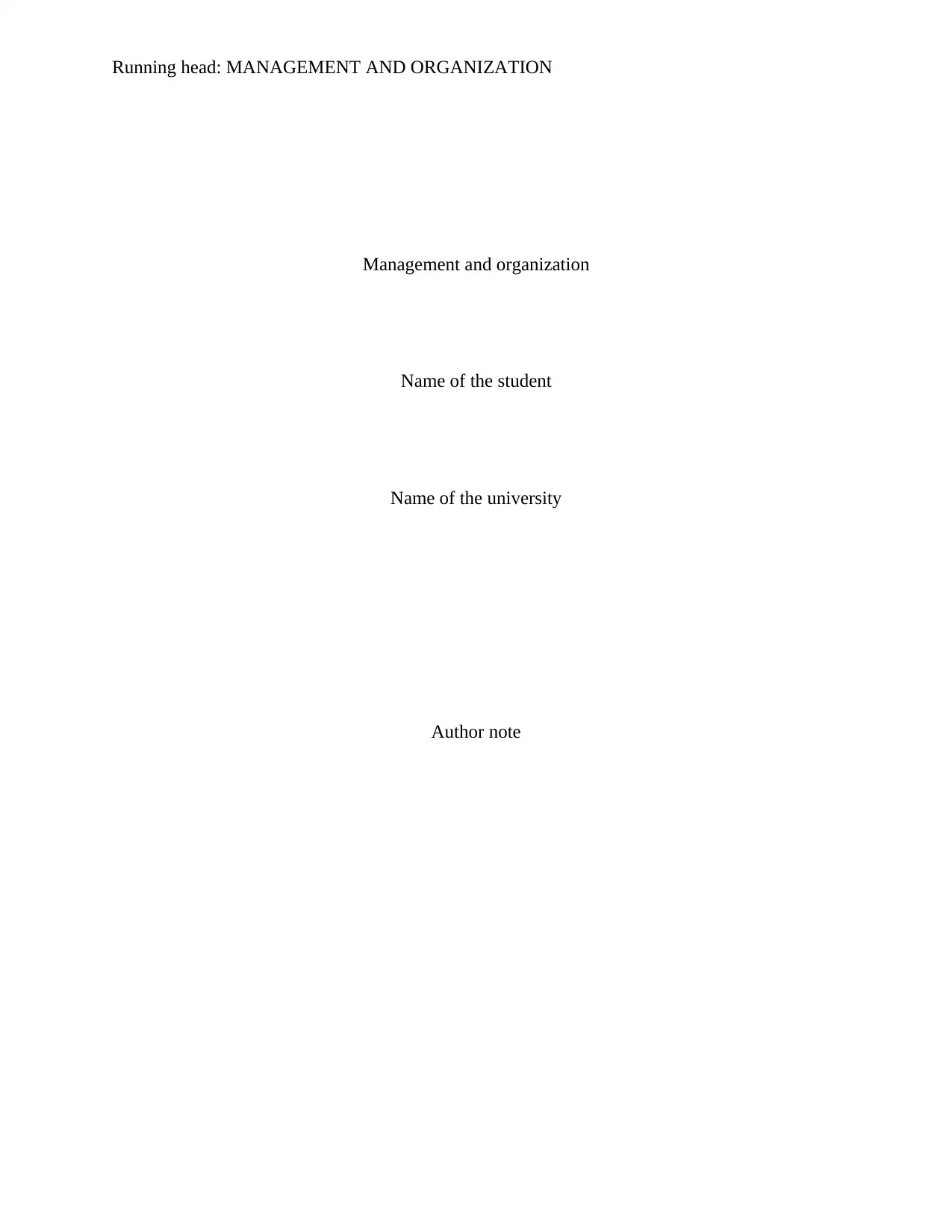
Running head: MANAGEMENT AND ORGANIZATION
Management and organization
Name of the student
Name of the university
Author note
Management and organization
Name of the student
Name of the university
Author note
Paraphrase This Document
Need a fresh take? Get an instant paraphrase of this document with our AI Paraphraser
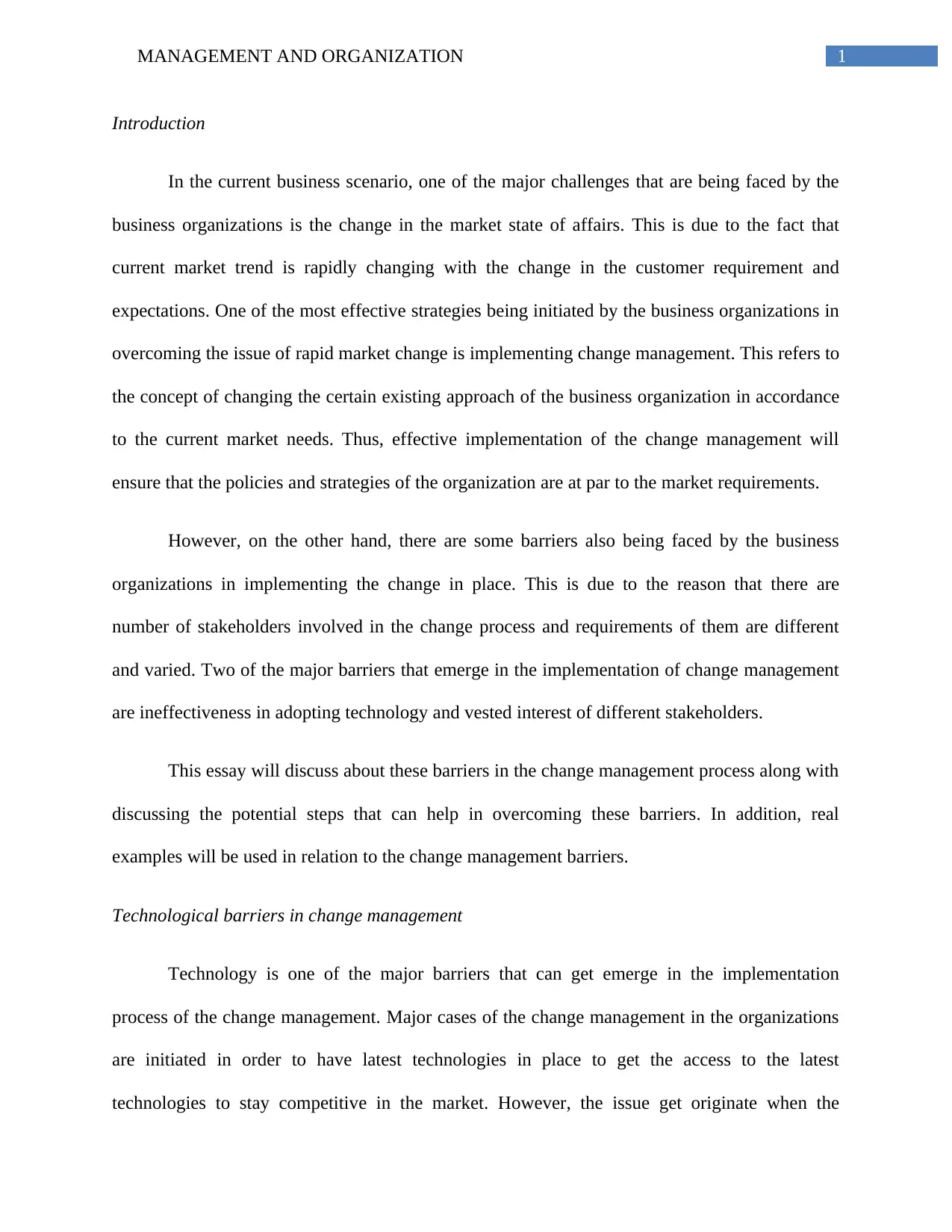
1MANAGEMENT AND ORGANIZATION
Introduction
In the current business scenario, one of the major challenges that are being faced by the
business organizations is the change in the market state of affairs. This is due to the fact that
current market trend is rapidly changing with the change in the customer requirement and
expectations. One of the most effective strategies being initiated by the business organizations in
overcoming the issue of rapid market change is implementing change management. This refers to
the concept of changing the certain existing approach of the business organization in accordance
to the current market needs. Thus, effective implementation of the change management will
ensure that the policies and strategies of the organization are at par to the market requirements.
However, on the other hand, there are some barriers also being faced by the business
organizations in implementing the change in place. This is due to the reason that there are
number of stakeholders involved in the change process and requirements of them are different
and varied. Two of the major barriers that emerge in the implementation of change management
are ineffectiveness in adopting technology and vested interest of different stakeholders.
This essay will discuss about these barriers in the change management process along with
discussing the potential steps that can help in overcoming these barriers. In addition, real
examples will be used in relation to the change management barriers.
Technological barriers in change management
Technology is one of the major barriers that can get emerge in the implementation
process of the change management. Major cases of the change management in the organizations
are initiated in order to have latest technologies in place to get the access to the latest
technologies to stay competitive in the market. However, the issue get originate when the
Introduction
In the current business scenario, one of the major challenges that are being faced by the
business organizations is the change in the market state of affairs. This is due to the fact that
current market trend is rapidly changing with the change in the customer requirement and
expectations. One of the most effective strategies being initiated by the business organizations in
overcoming the issue of rapid market change is implementing change management. This refers to
the concept of changing the certain existing approach of the business organization in accordance
to the current market needs. Thus, effective implementation of the change management will
ensure that the policies and strategies of the organization are at par to the market requirements.
However, on the other hand, there are some barriers also being faced by the business
organizations in implementing the change in place. This is due to the reason that there are
number of stakeholders involved in the change process and requirements of them are different
and varied. Two of the major barriers that emerge in the implementation of change management
are ineffectiveness in adopting technology and vested interest of different stakeholders.
This essay will discuss about these barriers in the change management process along with
discussing the potential steps that can help in overcoming these barriers. In addition, real
examples will be used in relation to the change management barriers.
Technological barriers in change management
Technology is one of the major barriers that can get emerge in the implementation
process of the change management. Major cases of the change management in the organizations
are initiated in order to have latest technologies in place to get the access to the latest
technologies to stay competitive in the market. However, the issue get originate when the
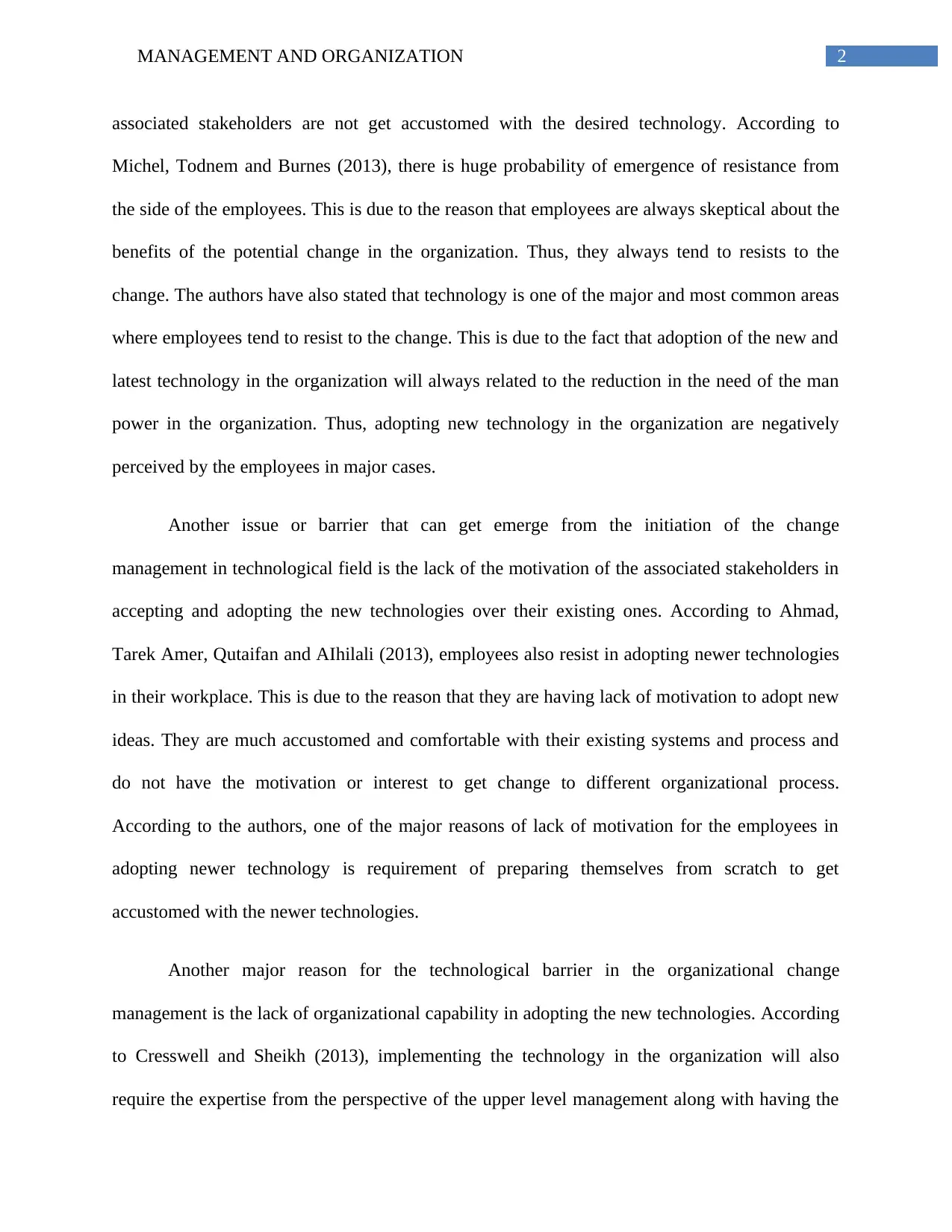
2MANAGEMENT AND ORGANIZATION
associated stakeholders are not get accustomed with the desired technology. According to
Michel, Todnem and Burnes (2013), there is huge probability of emergence of resistance from
the side of the employees. This is due to the reason that employees are always skeptical about the
benefits of the potential change in the organization. Thus, they always tend to resists to the
change. The authors have also stated that technology is one of the major and most common areas
where employees tend to resist to the change. This is due to the fact that adoption of the new and
latest technology in the organization will always related to the reduction in the need of the man
power in the organization. Thus, adopting new technology in the organization are negatively
perceived by the employees in major cases.
Another issue or barrier that can get emerge from the initiation of the change
management in technological field is the lack of the motivation of the associated stakeholders in
accepting and adopting the new technologies over their existing ones. According to Ahmad,
Tarek Amer, Qutaifan and AIhilali (2013), employees also resist in adopting newer technologies
in their workplace. This is due to the reason that they are having lack of motivation to adopt new
ideas. They are much accustomed and comfortable with their existing systems and process and
do not have the motivation or interest to get change to different organizational process.
According to the authors, one of the major reasons of lack of motivation for the employees in
adopting newer technology is requirement of preparing themselves from scratch to get
accustomed with the newer technologies.
Another major reason for the technological barrier in the organizational change
management is the lack of organizational capability in adopting the new technologies. According
to Cresswell and Sheikh (2013), implementing the technology in the organization will also
require the expertise from the perspective of the upper level management along with having the
associated stakeholders are not get accustomed with the desired technology. According to
Michel, Todnem and Burnes (2013), there is huge probability of emergence of resistance from
the side of the employees. This is due to the reason that employees are always skeptical about the
benefits of the potential change in the organization. Thus, they always tend to resists to the
change. The authors have also stated that technology is one of the major and most common areas
where employees tend to resist to the change. This is due to the fact that adoption of the new and
latest technology in the organization will always related to the reduction in the need of the man
power in the organization. Thus, adopting new technology in the organization are negatively
perceived by the employees in major cases.
Another issue or barrier that can get emerge from the initiation of the change
management in technological field is the lack of the motivation of the associated stakeholders in
accepting and adopting the new technologies over their existing ones. According to Ahmad,
Tarek Amer, Qutaifan and AIhilali (2013), employees also resist in adopting newer technologies
in their workplace. This is due to the reason that they are having lack of motivation to adopt new
ideas. They are much accustomed and comfortable with their existing systems and process and
do not have the motivation or interest to get change to different organizational process.
According to the authors, one of the major reasons of lack of motivation for the employees in
adopting newer technology is requirement of preparing themselves from scratch to get
accustomed with the newer technologies.
Another major reason for the technological barrier in the organizational change
management is the lack of organizational capability in adopting the new technologies. According
to Cresswell and Sheikh (2013), implementing the technology in the organization will also
require the expertise from the perspective of the upper level management along with having the
⊘ This is a preview!⊘
Do you want full access?
Subscribe today to unlock all pages.

Trusted by 1+ million students worldwide
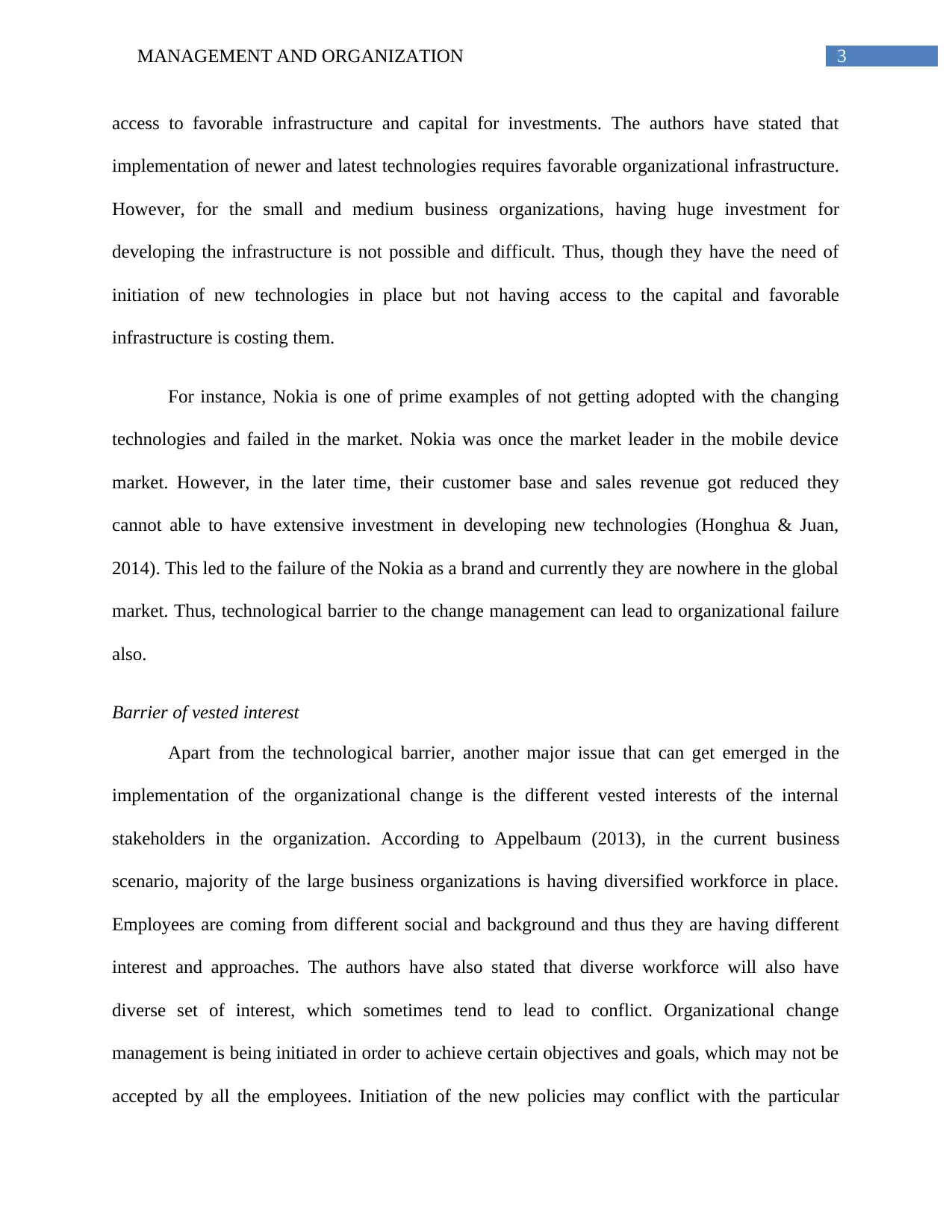
3MANAGEMENT AND ORGANIZATION
access to favorable infrastructure and capital for investments. The authors have stated that
implementation of newer and latest technologies requires favorable organizational infrastructure.
However, for the small and medium business organizations, having huge investment for
developing the infrastructure is not possible and difficult. Thus, though they have the need of
initiation of new technologies in place but not having access to the capital and favorable
infrastructure is costing them.
For instance, Nokia is one of prime examples of not getting adopted with the changing
technologies and failed in the market. Nokia was once the market leader in the mobile device
market. However, in the later time, their customer base and sales revenue got reduced they
cannot able to have extensive investment in developing new technologies (Honghua & Juan,
2014). This led to the failure of the Nokia as a brand and currently they are nowhere in the global
market. Thus, technological barrier to the change management can lead to organizational failure
also.
Barrier of vested interest
Apart from the technological barrier, another major issue that can get emerged in the
implementation of the organizational change is the different vested interests of the internal
stakeholders in the organization. According to Appelbaum (2013), in the current business
scenario, majority of the large business organizations is having diversified workforce in place.
Employees are coming from different social and background and thus they are having different
interest and approaches. The authors have also stated that diverse workforce will also have
diverse set of interest, which sometimes tend to lead to conflict. Organizational change
management is being initiated in order to achieve certain objectives and goals, which may not be
accepted by all the employees. Initiation of the new policies may conflict with the particular
access to favorable infrastructure and capital for investments. The authors have stated that
implementation of newer and latest technologies requires favorable organizational infrastructure.
However, for the small and medium business organizations, having huge investment for
developing the infrastructure is not possible and difficult. Thus, though they have the need of
initiation of new technologies in place but not having access to the capital and favorable
infrastructure is costing them.
For instance, Nokia is one of prime examples of not getting adopted with the changing
technologies and failed in the market. Nokia was once the market leader in the mobile device
market. However, in the later time, their customer base and sales revenue got reduced they
cannot able to have extensive investment in developing new technologies (Honghua & Juan,
2014). This led to the failure of the Nokia as a brand and currently they are nowhere in the global
market. Thus, technological barrier to the change management can lead to organizational failure
also.
Barrier of vested interest
Apart from the technological barrier, another major issue that can get emerged in the
implementation of the organizational change is the different vested interests of the internal
stakeholders in the organization. According to Appelbaum (2013), in the current business
scenario, majority of the large business organizations is having diversified workforce in place.
Employees are coming from different social and background and thus they are having different
interest and approaches. The authors have also stated that diverse workforce will also have
diverse set of interest, which sometimes tend to lead to conflict. Organizational change
management is being initiated in order to achieve certain objectives and goals, which may not be
accepted by all the employees. Initiation of the new policies may conflict with the particular
Paraphrase This Document
Need a fresh take? Get an instant paraphrase of this document with our AI Paraphraser
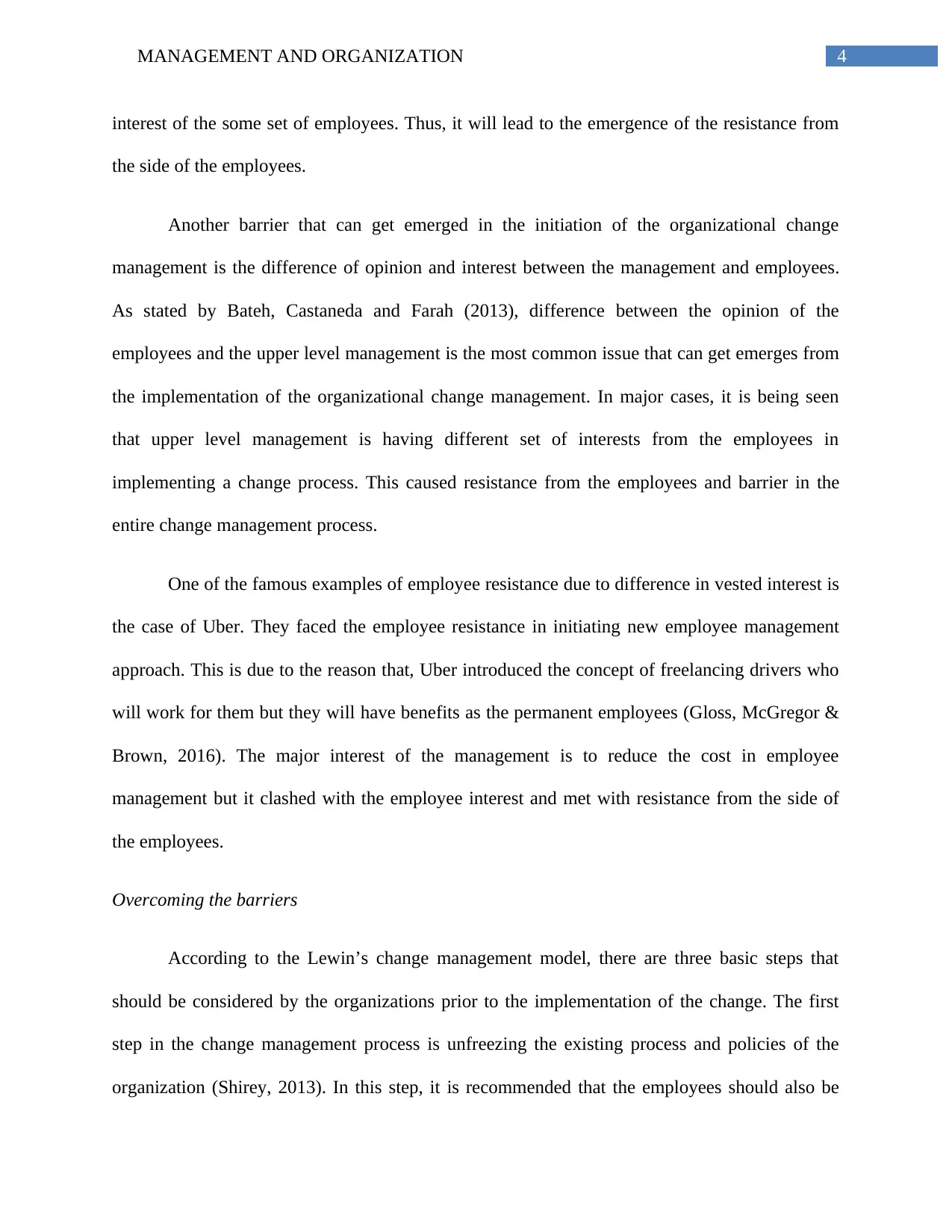
4MANAGEMENT AND ORGANIZATION
interest of the some set of employees. Thus, it will lead to the emergence of the resistance from
the side of the employees.
Another barrier that can get emerged in the initiation of the organizational change
management is the difference of opinion and interest between the management and employees.
As stated by Bateh, Castaneda and Farah (2013), difference between the opinion of the
employees and the upper level management is the most common issue that can get emerges from
the implementation of the organizational change management. In major cases, it is being seen
that upper level management is having different set of interests from the employees in
implementing a change process. This caused resistance from the employees and barrier in the
entire change management process.
One of the famous examples of employee resistance due to difference in vested interest is
the case of Uber. They faced the employee resistance in initiating new employee management
approach. This is due to the reason that, Uber introduced the concept of freelancing drivers who
will work for them but they will have benefits as the permanent employees (Gloss, McGregor &
Brown, 2016). The major interest of the management is to reduce the cost in employee
management but it clashed with the employee interest and met with resistance from the side of
the employees.
Overcoming the barriers
According to the Lewin’s change management model, there are three basic steps that
should be considered by the organizations prior to the implementation of the change. The first
step in the change management process is unfreezing the existing process and policies of the
organization (Shirey, 2013). In this step, it is recommended that the employees should also be
interest of the some set of employees. Thus, it will lead to the emergence of the resistance from
the side of the employees.
Another barrier that can get emerged in the initiation of the organizational change
management is the difference of opinion and interest between the management and employees.
As stated by Bateh, Castaneda and Farah (2013), difference between the opinion of the
employees and the upper level management is the most common issue that can get emerges from
the implementation of the organizational change management. In major cases, it is being seen
that upper level management is having different set of interests from the employees in
implementing a change process. This caused resistance from the employees and barrier in the
entire change management process.
One of the famous examples of employee resistance due to difference in vested interest is
the case of Uber. They faced the employee resistance in initiating new employee management
approach. This is due to the reason that, Uber introduced the concept of freelancing drivers who
will work for them but they will have benefits as the permanent employees (Gloss, McGregor &
Brown, 2016). The major interest of the management is to reduce the cost in employee
management but it clashed with the employee interest and met with resistance from the side of
the employees.
Overcoming the barriers
According to the Lewin’s change management model, there are three basic steps that
should be considered by the organizations prior to the implementation of the change. The first
step in the change management process is unfreezing the existing process and policies of the
organization (Shirey, 2013). In this step, it is recommended that the employees should also be
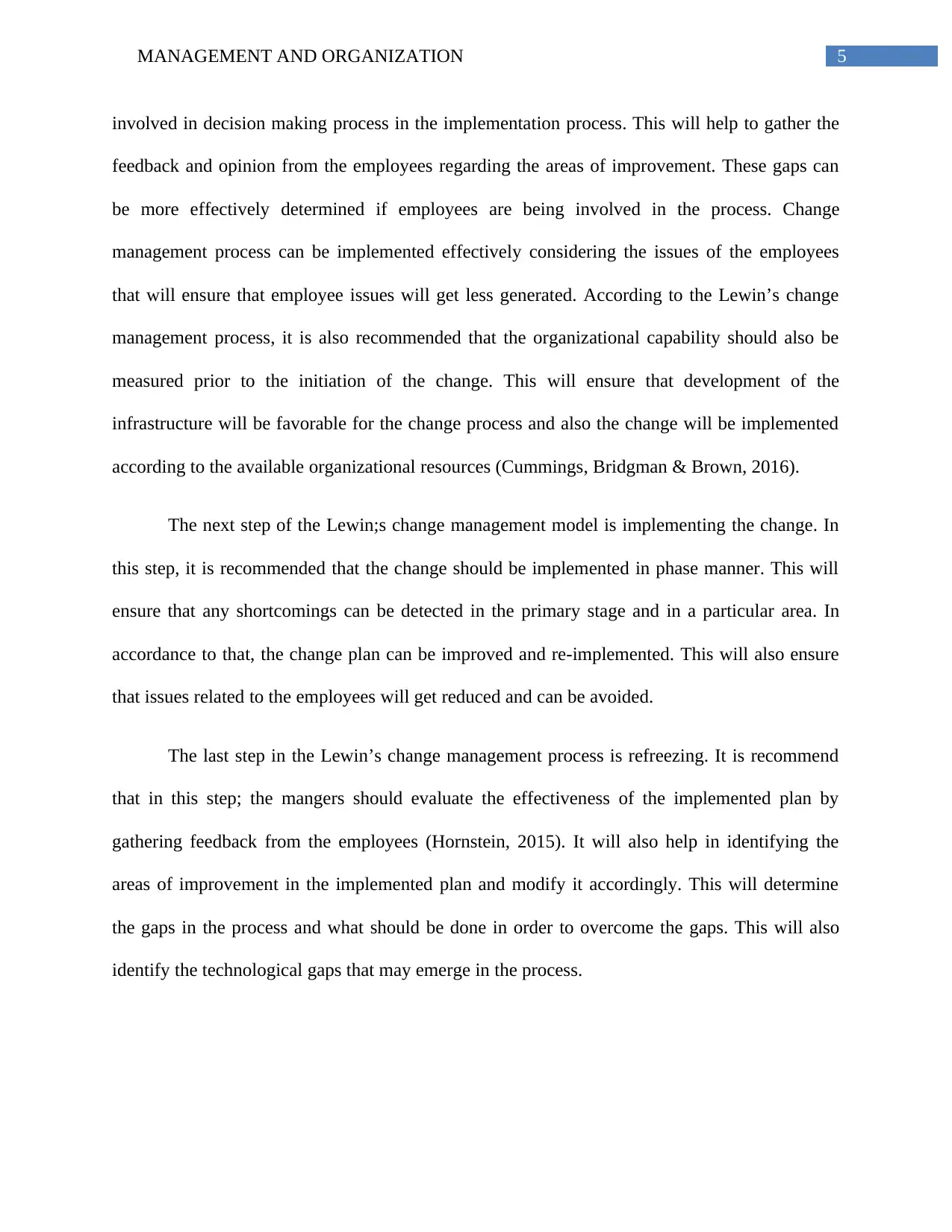
5MANAGEMENT AND ORGANIZATION
involved in decision making process in the implementation process. This will help to gather the
feedback and opinion from the employees regarding the areas of improvement. These gaps can
be more effectively determined if employees are being involved in the process. Change
management process can be implemented effectively considering the issues of the employees
that will ensure that employee issues will get less generated. According to the Lewin’s change
management process, it is also recommended that the organizational capability should also be
measured prior to the initiation of the change. This will ensure that development of the
infrastructure will be favorable for the change process and also the change will be implemented
according to the available organizational resources (Cummings, Bridgman & Brown, 2016).
The next step of the Lewin;s change management model is implementing the change. In
this step, it is recommended that the change should be implemented in phase manner. This will
ensure that any shortcomings can be detected in the primary stage and in a particular area. In
accordance to that, the change plan can be improved and re-implemented. This will also ensure
that issues related to the employees will get reduced and can be avoided.
The last step in the Lewin’s change management process is refreezing. It is recommend
that in this step; the mangers should evaluate the effectiveness of the implemented plan by
gathering feedback from the employees (Hornstein, 2015). It will also help in identifying the
areas of improvement in the implemented plan and modify it accordingly. This will determine
the gaps in the process and what should be done in order to overcome the gaps. This will also
identify the technological gaps that may emerge in the process.
involved in decision making process in the implementation process. This will help to gather the
feedback and opinion from the employees regarding the areas of improvement. These gaps can
be more effectively determined if employees are being involved in the process. Change
management process can be implemented effectively considering the issues of the employees
that will ensure that employee issues will get less generated. According to the Lewin’s change
management process, it is also recommended that the organizational capability should also be
measured prior to the initiation of the change. This will ensure that development of the
infrastructure will be favorable for the change process and also the change will be implemented
according to the available organizational resources (Cummings, Bridgman & Brown, 2016).
The next step of the Lewin;s change management model is implementing the change. In
this step, it is recommended that the change should be implemented in phase manner. This will
ensure that any shortcomings can be detected in the primary stage and in a particular area. In
accordance to that, the change plan can be improved and re-implemented. This will also ensure
that issues related to the employees will get reduced and can be avoided.
The last step in the Lewin’s change management process is refreezing. It is recommend
that in this step; the mangers should evaluate the effectiveness of the implemented plan by
gathering feedback from the employees (Hornstein, 2015). It will also help in identifying the
areas of improvement in the implemented plan and modify it accordingly. This will determine
the gaps in the process and what should be done in order to overcome the gaps. This will also
identify the technological gaps that may emerge in the process.
⊘ This is a preview!⊘
Do you want full access?
Subscribe today to unlock all pages.

Trusted by 1+ million students worldwide
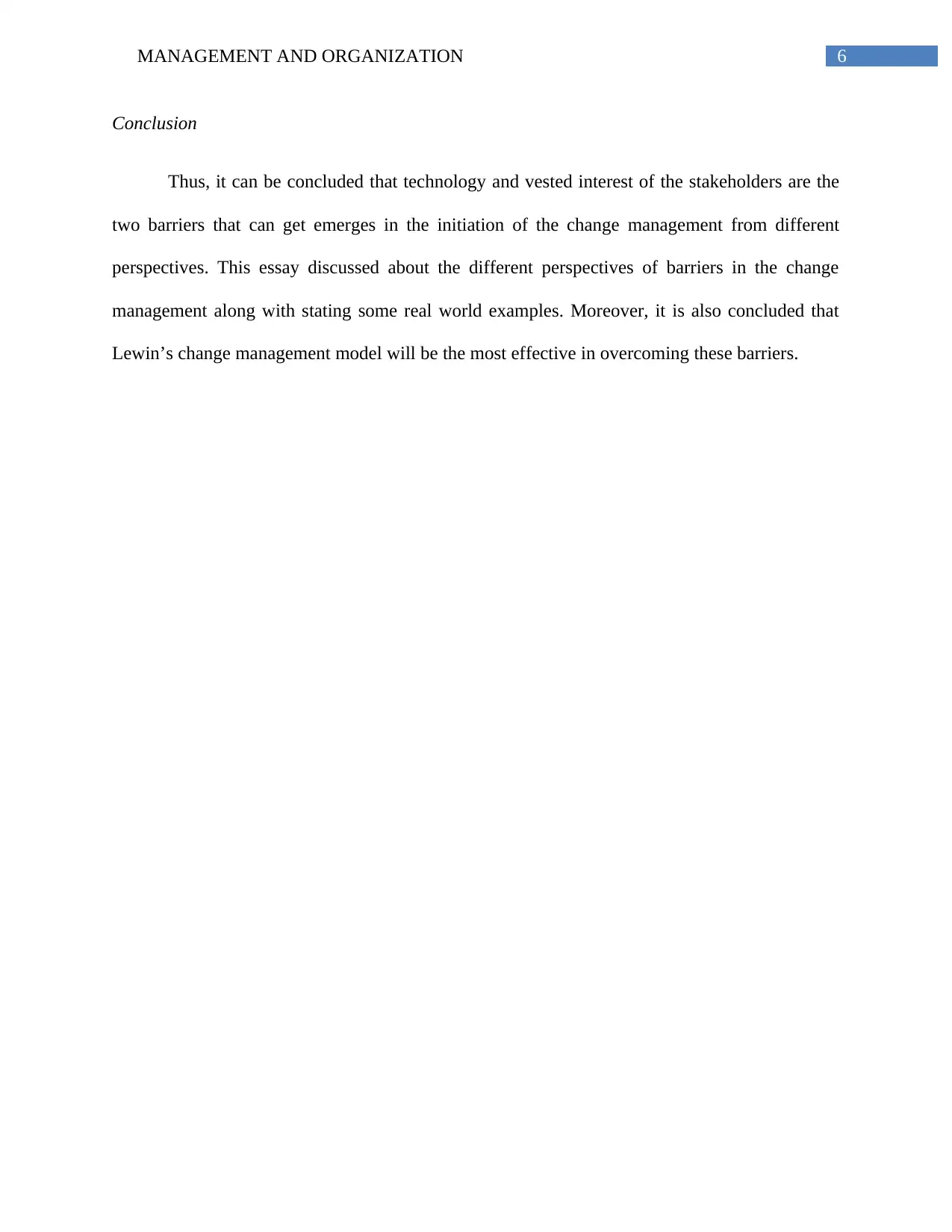
6MANAGEMENT AND ORGANIZATION
Conclusion
Thus, it can be concluded that technology and vested interest of the stakeholders are the
two barriers that can get emerges in the initiation of the change management from different
perspectives. This essay discussed about the different perspectives of barriers in the change
management along with stating some real world examples. Moreover, it is also concluded that
Lewin’s change management model will be the most effective in overcoming these barriers.
Conclusion
Thus, it can be concluded that technology and vested interest of the stakeholders are the
two barriers that can get emerges in the initiation of the change management from different
perspectives. This essay discussed about the different perspectives of barriers in the change
management along with stating some real world examples. Moreover, it is also concluded that
Lewin’s change management model will be the most effective in overcoming these barriers.
Paraphrase This Document
Need a fresh take? Get an instant paraphrase of this document with our AI Paraphraser
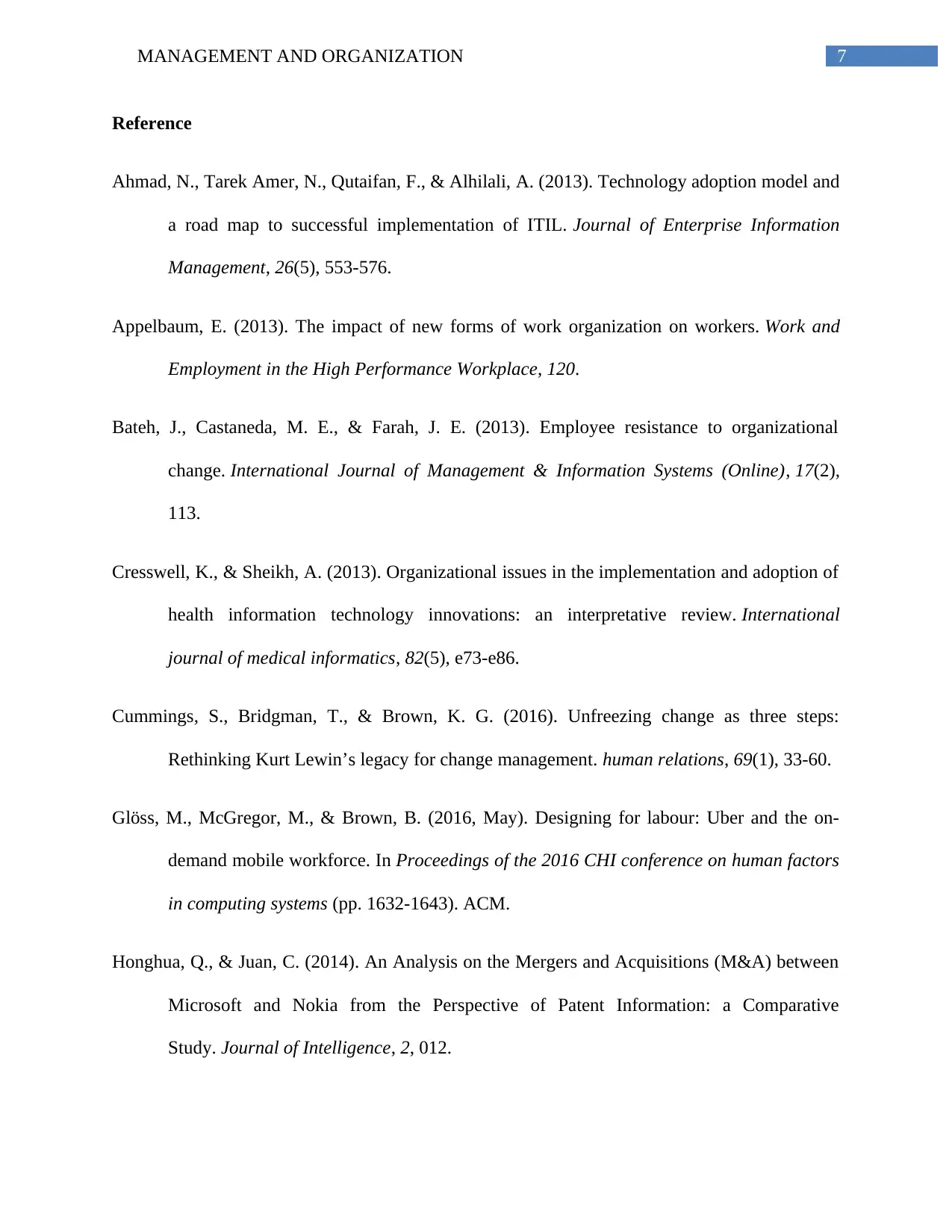
7MANAGEMENT AND ORGANIZATION
Reference
Ahmad, N., Tarek Amer, N., Qutaifan, F., & Alhilali, A. (2013). Technology adoption model and
a road map to successful implementation of ITIL. Journal of Enterprise Information
Management, 26(5), 553-576.
Appelbaum, E. (2013). The impact of new forms of work organization on workers. Work and
Employment in the High Performance Workplace, 120.
Bateh, J., Castaneda, M. E., & Farah, J. E. (2013). Employee resistance to organizational
change. International Journal of Management & Information Systems (Online), 17(2),
113.
Cresswell, K., & Sheikh, A. (2013). Organizational issues in the implementation and adoption of
health information technology innovations: an interpretative review. International
journal of medical informatics, 82(5), e73-e86.
Cummings, S., Bridgman, T., & Brown, K. G. (2016). Unfreezing change as three steps:
Rethinking Kurt Lewin’s legacy for change management. human relations, 69(1), 33-60.
Glöss, M., McGregor, M., & Brown, B. (2016, May). Designing for labour: Uber and the on-
demand mobile workforce. In Proceedings of the 2016 CHI conference on human factors
in computing systems (pp. 1632-1643). ACM.
Honghua, Q., & Juan, C. (2014). An Analysis on the Mergers and Acquisitions (M&A) between
Microsoft and Nokia from the Perspective of Patent Information: a Comparative
Study. Journal of Intelligence, 2, 012.
Reference
Ahmad, N., Tarek Amer, N., Qutaifan, F., & Alhilali, A. (2013). Technology adoption model and
a road map to successful implementation of ITIL. Journal of Enterprise Information
Management, 26(5), 553-576.
Appelbaum, E. (2013). The impact of new forms of work organization on workers. Work and
Employment in the High Performance Workplace, 120.
Bateh, J., Castaneda, M. E., & Farah, J. E. (2013). Employee resistance to organizational
change. International Journal of Management & Information Systems (Online), 17(2),
113.
Cresswell, K., & Sheikh, A. (2013). Organizational issues in the implementation and adoption of
health information technology innovations: an interpretative review. International
journal of medical informatics, 82(5), e73-e86.
Cummings, S., Bridgman, T., & Brown, K. G. (2016). Unfreezing change as three steps:
Rethinking Kurt Lewin’s legacy for change management. human relations, 69(1), 33-60.
Glöss, M., McGregor, M., & Brown, B. (2016, May). Designing for labour: Uber and the on-
demand mobile workforce. In Proceedings of the 2016 CHI conference on human factors
in computing systems (pp. 1632-1643). ACM.
Honghua, Q., & Juan, C. (2014). An Analysis on the Mergers and Acquisitions (M&A) between
Microsoft and Nokia from the Perspective of Patent Information: a Comparative
Study. Journal of Intelligence, 2, 012.
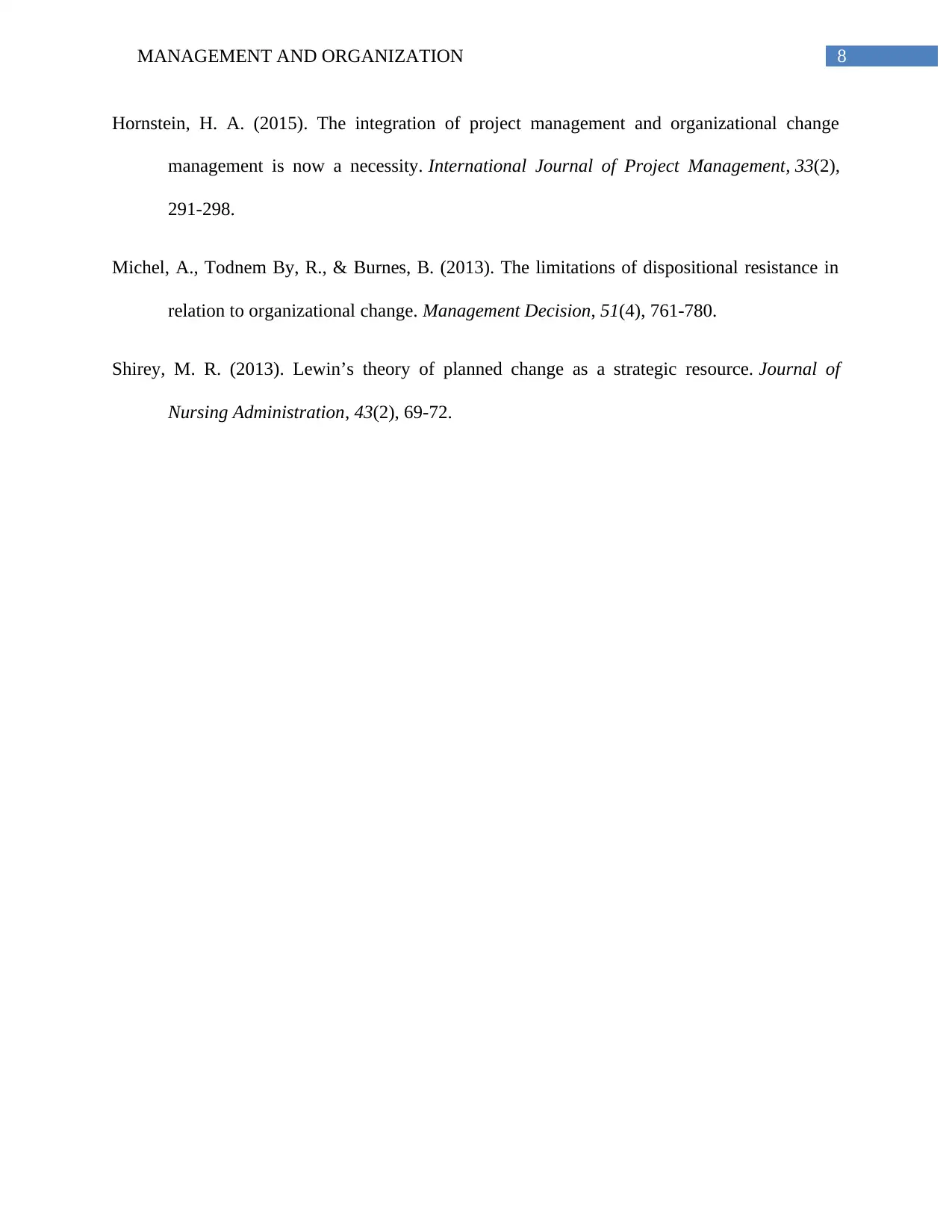
8MANAGEMENT AND ORGANIZATION
Hornstein, H. A. (2015). The integration of project management and organizational change
management is now a necessity. International Journal of Project Management, 33(2),
291-298.
Michel, A., Todnem By, R., & Burnes, B. (2013). The limitations of dispositional resistance in
relation to organizational change. Management Decision, 51(4), 761-780.
Shirey, M. R. (2013). Lewin’s theory of planned change as a strategic resource. Journal of
Nursing Administration, 43(2), 69-72.
Hornstein, H. A. (2015). The integration of project management and organizational change
management is now a necessity. International Journal of Project Management, 33(2),
291-298.
Michel, A., Todnem By, R., & Burnes, B. (2013). The limitations of dispositional resistance in
relation to organizational change. Management Decision, 51(4), 761-780.
Shirey, M. R. (2013). Lewin’s theory of planned change as a strategic resource. Journal of
Nursing Administration, 43(2), 69-72.
⊘ This is a preview!⊘
Do you want full access?
Subscribe today to unlock all pages.

Trusted by 1+ million students worldwide
1 out of 9
Related Documents
Your All-in-One AI-Powered Toolkit for Academic Success.
+13062052269
info@desklib.com
Available 24*7 on WhatsApp / Email
![[object Object]](/_next/static/media/star-bottom.7253800d.svg)
Unlock your academic potential
Copyright © 2020–2025 A2Z Services. All Rights Reserved. Developed and managed by ZUCOL.



